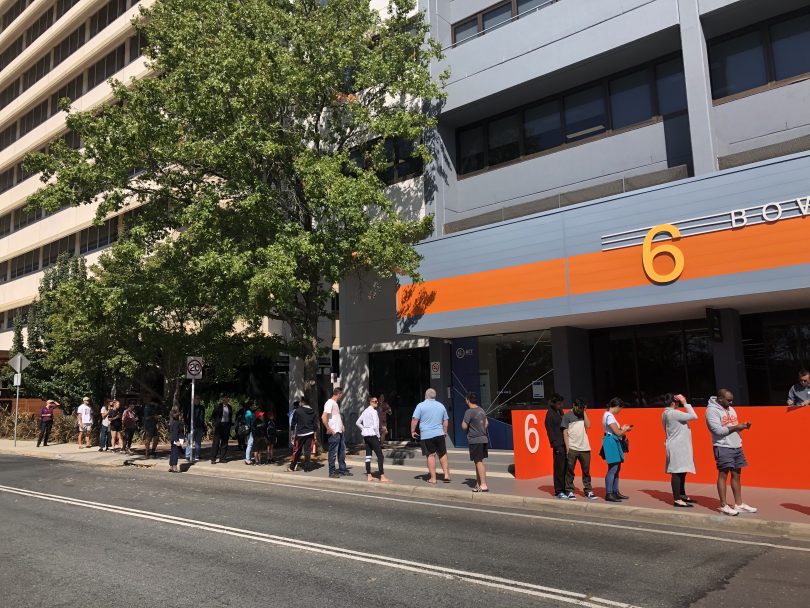
Applicants queueing for JobSeeker and JobKeeper when the programs were first announced in March. Photo: Dominic Giannini.
Tens of thousands of Canberrans are set to have their JobSeeker and JobKeeper payments reduced in September after the Commonwealth announced it would extend the schemes but at a lower rate.
Ellie McEwan, who works at the Southern Cross Club in Jamison, is one of the thousands of workers who are concerned about what the decrease could mean for her income.
“My shifts are always changing because of university so the amount I was able to earn every week changed,” she said.
“But JobKeeper meant I was able to save a lot because I got the same amount every fortnight, and now I am worried about how much I’ll be able to make every week.”
Ellie’s savings mean she would be able to support herself if something were to suddenly happen to her income; however, digging into her savings is a last resort, she said.
A common criticism of the standardised $1,500 payment is that some casuals and part-time workers are earning more on JobKeeper than they are from working, providing a disincentive to pick up more shifts while on the flat payment.
However, Ellie says this is not the case.
“I am happy to do any shifts that I am offered or that pop up because the business still needs to remain open and I do not want to become complacent and for work to think I am unreliable,” she said.

Ellie McEwan is one of the thousands of Canberrans on the JobKeeper payment, which is set to be decreased from September. Photo: Supplied.
In the ACT, around 14,650 people are currently receiving the $1,100 fortnightly JobSeeker supplement, while about 11,500 businesses in the ACT – including Jervis Bay – have employees receiving the $1,500 fortnightly JobKeeper payment.
The $1,500 fortnightly Jobkeeper subsidy, which was set to end in September, will be extended for another six months until March 2021, but will be paid at a lower rate and eligibility requirements will be tightened for its 3.5 million recipients.
The payment will be reduced to $1,200 a fortnight for fulltime workers from the end of September, and $750 a fortnight for people working 20 hours a week or less.
The $1,100-a-fortnight JobSeeker payment, which covers another 1.6 million Australians, will also be tweaked. The former Newstart payment was increased at the start of the pandemic to $550 a week, and while this rate will continue until September, a lower rate will be paid from September until December.
These changes will run until the end of the year.
Those receiving the JobSeeker payment will also need to undertake four job searches a month from 4 August and this will rise from the end of September.
ANU economic growth expert Professor Robert Breunig, who has been studying JobKeeper and JobSeeker, says the changes are a step in the right direction.
“This will provide certainty going forward,” he said.
“The program made sense when you wanted to press pause on the economy but it is not the right program when you want to press play.”
Professor Breunig says the two major problems having a $1,500 standard rate for JobKeeper are that the payment amounts to more than what some workers were previously earning, providing fewer incentives to take up extra shifts and work.
It is also a bad way to deliver payments through the business which then passes it on to the workers, as employees cannot move jobs and change roles which is what would normally happen in the workplace.
“It is going to help a little but the big problem that we have is that the coronavirus means a whole lot of businesses cannot run their operations as normal,” Professor Breunig said.
“This is not like the global financial crisis where there was a crisis of confidence and the government pumped money into the economy to give people confidence that they can go out and spend money.
“Even if the Government gives people money, they cannot buy a plane ticket, they cannot go to a sporting event, they cannot go to the movie theatre and so that is the big thing that is going to hold the economy back.”
Changes to JobKeeper and JobSeeker were announced after a review of the programs was presented to the Federal Government in June.













